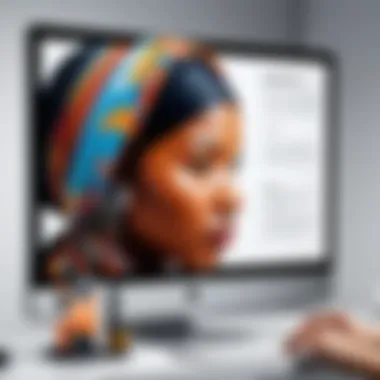Clash of Cultures: Navigating Global Diversity Challenges


Intro
Cultural diversity is like a double-edged sword; it can cut both ways. On one hand, it enriches societies, while on the other, it often complicates relationships among communities. In this interconnected world, where borders blur under the weight of global interaction, understanding cultural dynamics becomes not just relevant but essential. This exploration aims to shed light on the simmering tensions, historical contexts, and sociopolitical realities that shape our day-to-day interactions.
As we navigate these complexities, we realize that the 'clash of cultures' is not merely a matter of different practices or traditions colliding. It's often a battleground of identity, power, and coexistence. With the rising flow of migrants, varied belief systems, and shifting social norms, cultures frequently find themselves at odds, creating ripples that affect everything from community cohesion to policymaking.
In this article, we will dissect these phenomena, offering insights into how we can better understand and resolve cultural conflicts. By introducing relevant case studies and theoretical frameworks, readers will witness how coexistence is possible, and even beneficial, within supposedly oppositional cultural landscapes. The ensuing sections will take us through various lenses—historical, sociopolitical, and technological—yielding a comprehensive picture of today's society.
Foreword to Cultural Clashes
Understanding cultural clashes has become essential in navigating our increasingly interconnected world. As societies intertwine through globalization, the juxtaposition of diverse cultural practices can lead to beneficial exchanges and, conversely, conflict. The reality is that with every meaningful interaction, there's potential for misunderstanding when different cultural norms collide. Thus, examining this introduction to cultural clashes serves several vital functions in our exploration.
First, it helps lay the groundwork for discussion, offering a robust framework for identifying what these clashes really mean. From misunderstandings over social norms to competing beliefs, acknowledged clashes are often mirrors reflecting broader societal tensions. To fathom how these moments manifest in real life requires context, and this article promises to unpack that.
Second, identifying the factors contributing to cultural clashes brings clarity to a multifaceted issue. Consider the lanes of identity and social belonging that heavily influence individual perspectives. When various belief systems intersect, one could say it’s a recipe for friction unless those involved adopt an attitude of empathy and curiosity.
Equally important is the potential for positive outcomes born from these encounters. When diverse groups engage compassionately, they can foster mutual respect and pave the way for innovative problem-solving. Hence, the exploration of cultural clashes isn't merely a critique; it's an insightful look at how societies evolve collectively.
Finally, examining cultural clashes provides a springboard into practical solutions—how do we foster cohesion without sacrifice? So many lessons can be gleaned from historical incidents and present-day scenarios.
As we transition to the ensuing subsections, let's aim to understand these concepts in-depth, starting with the definitions and contextualization of cultural clashes, setting the stage for a deeper investigation.
Definition and Contextualization
At its core, a cultural clash refers to a situation where two or more cultures encounter each other, often leading to misunderstanding, conflict, or even confrontation. However, this definition seems far too simplistic considering the complex web of influences that fuel these encounters.
To contextualize, let’s think back to simpler times—a home in a rural village, where generations instill values, customs, and social codes. Now imagine the hustle and bustle of a bustling urban center, teeming with people from all walks of life. Suddenly, the traditional values of that village may face scrutiny when they brush against the fast-moving, often more liberal ideologies of city life.
Cultural clashes can therefore be seen as a misalignment of expectations, where behaviors, speech, and even silence can be interpreted starkly different. This divergence can manifest in educational settings, workplaces, and within social circles, leading to conflicts that can escalate if not addressed properly.
Furthermore, as societies evolve, so do the elements that constitute culture—language, rituals, food, and dress. Each layer adds nuance to the clash, making it essential to grasp the historical context behind these encounters. Through this understanding comes awareness of the intersectionality present in cultural dynamics, shaping our responses and helping us navigate these choppy waters better.
Historical Precedence of Cultural Conflicts
Cultural clashes aren't a novel phenomenon; rather, they echo through time. The history of humanity is, in many ways, punctuated by these conflicts, a reflection of societies grappling with differences. One prominent example that stands out is the colonization of the Americas. European powers brought not just their technologies but also their languages and belief systems, clashing fundamentally with Indigenous traditions and ways of life.
The ramifications were immense, with indigenous tribes facing upheaval, displacement, and a struggle to maintain their cultural identity in the wake of outside influences. This instance underscores how historical power dynamics shape present cultural landscapes, often sowing seeds of resentment and misunderstanding.
Another notable chapter is that of the Silk Road, where traders and travelers brought not only goods but also cultural exchange that both enriched and complicated relationships between various civilizations. It serves as an early example of cultural blending, hinting at the duality of clashes that can give rise to enrichment and enmity alike.
As we analyze these historical touchpoints, it becomes evident that cultural conflicts often lead to lasting changes, paving pathways for both integration and resistance. Undoubtedly, understanding this complex historical precedence allows us to navigate contemporary cultural landscapes with wisely, informed awareness.
"Culture is not a static entity; it is a living force, shaped continuously by exchanges and clashes among societies."
Through this understanding of cultural clashes, readers can gain a broader perspective on the intricate tapestry of global interactions, setting the stage for further exploration in upcoming sections.
The Role of Globalization
Globalization plays a pivotal role in shaping the dynamics of cultural clashes among societies. It acts as a double-edged sword, weaving together diverse cultures while simultaneously giving rise to tensions and misunderstandings. Understanding its influence is essential to grasp the complexity of interactions that occur when different ways of life intersect. In this fast-paced world where borders seem less relevant, the cultural exchange is no longer a phenomenon that takes decades. Instead, it has accelerated dramatically, transforming local customs and practices almost overnight.
Acceleration of Cultural Exchange
The pace of cultural exchange today is like a high-speed train racing through a landscape of tradition and innovation. People are more mobile than ever before; think about how instant messaging or travel has created a web of connections that cuts across oceans. This phenomenon is visible in various realms, from cuisine to fashion. For instance, the popularity of sushi in the United States has led to a redefinition of traditional Japanese cuisine, while simultaneously creating new forms of hybrid foods, such as sushi burritos.
Yet, this rapid exchange isn’t always rosy. As cultures collide, there can be a pushback from communities wanting to protect their identities. Just look at the global reaction to the spread of fast food chains; certain locales have actively campaigned to promote their traditional cuisines as a counter-movement. The benefits are clear—exposure to diverse ideas and practices can foster innovation. However, this also ushers in the risk of cultural dilution. Each exchange leaves marks that are not easily erased, affecting how communities view themselves and their traditions.
Economic Influences on Cultural Dynamics


Economics ties closely with cultural interactions, creating a landscape where cultural clashes often bear economic roots. The globalization of trade and business not only brings in different markets but also introduces novel practices and expectations. For instance, when Western companies enter emerging markets, they often bring along their corporate cultures, leading to friction with local business customs.
Moreover, income disparities can intensify these cultural tensions. In many instances, wealthy nations create myriad opportunities for partnerships, yet they impose their values onto those in developing regions. This is apparent in regions rich in resources, where foreign investment leads to an influx of new practices that may overshadow local traditions.
"Cultural influences are neither inherently good nor bad; rather they are the subtle strings that tie communities together, often fraying under the strain of economic ambitions."
In summary, globalization is not just a phenomenon to observe but a powerful force that shapes cultural dynamics. Understanding its mechanisms helps illuminate the intricate dance between exchange and conflict. The nuances of cultural interactions hinge significantly on how economic considerations guide the exchange. By taking a closer look at these dynamics, one can glean valuable insights into how societies might come together or drift apart.
Sociopolitical factors
Understanding the sociopolitical landscape is essential when examining cultural clashes. This topic sheds light on how power, governance, and social hierarchies shape interpersonal and intergroup relations. We live in a world where resources, whether they be political, social, or economic, influence cultural interactions. Addressing these factors helps us grapple with the complexities of different societies encountering one another.
In this section, we will explore two key elements:
- Power Structures and Their Impact
- Colonialism and Its Lingering Effects
Through this lens, readers can appreciate the nuances that contribute to cultural tensions and collaborations alike.
Power Structures and Their Impact
Power dynamics often dictate the rules of engagement between cultures. These structures manifest in various forms: government institutions, corporate entities, and social frameworks. Consider the way legislation might promote certain cultural practices while marginalizing others. Countries with robust democratic systems often see a more significant representation of diverse voices, but that isn't always the case.
For instance, in nations where authoritarian regimes prevail, minority cultures frequently find themselves at a disadvantage. This can lead to oppression and resistance, breeding cultural clashes.
When examining these encounters, it becomes clear that understanding power is not merely about identifying who holds authority. It's essential to look at how that power is executed—who gets to decide what is acceptable or unacceptable within a cultural context?
Moreover, these power relations can exert influence on global markets and create cultural hegemony. When a dominant culture overshadows others, it can generate feelings of resentment and resistance from those whose identities are threatened.
Colonialism and Its Lingering Effects
Colonialism is a significant chapter in the story of global cultural interactions. The aftershocks of colonial endeavors continue to affect formerly colonized societies. Many cultures are left grappling with the remnants of colonization, which often included the suppression of indigenous practices and languages. A historical example involves the British Empire’s influence in India, where the imposition of English not only marginalized local languages but also positioned Western values as superior.
"Colonialism not only extracted resources; it also extracted identities."
Today, the impacts are still apparent. Former colonial powers often construct narratives that prioritize their experiences while sidelining those of the affected countries.
Challenges like identity crises emerge as a result of these complicated legacies. People from former colonies may find themselves torn between embracing their cultural heritage and adapting to the influences imposed upon them. This disoriented state can lead to conflicts when these different layers of identity collide in multicultural settings.
Psychological Dimensions of Cultural Clashes
The psychological aspects play a significant role in the dynamics of cultural clashes. Understanding these dimensions offers insights into how individuals perceive and interact with different cultures. This section will detail the intricate ways identity and belonging intertwine with cultural interactions, as well as the impact of cognitive dissonance that may arise during these encounters.
Identity and Belonging
Identity formation is a complex tapestry woven from various threads, such as ethnicity, nationality, and personal experiences. Each individual holds a unique perspective towards their own identity, and when faced with differing cultural frameworks, the confrontation can be profound.
In many cases, this clash of identities can lead to a sense of alienation among individuals who feel their values, beliefs, or lifestyles are under siege. For instance, an immigrant moving to a new country might grapple with adhering to their original cultural norms while trying to adapt to the predominant culture. The psychological struggle here is palpable; they may feel as if they are caught between two worlds, never fully belonging to either. This sentiment can be akin to walking a tightrope, where one misstep can lead to losing touch with one's roots or failing to assimilate into the new environment.
Consider the plight of a second-generation immigrant. They live in a world shaped by their parents’ heritage, yet their daily interactions are with peers from different backgrounds. This position can foster a rich blend of cultures, but it can also result in an internal struggle for identity. Those seeking acceptance in a new culture might inadvertently push down their heritage, leading to a diminished sense of self.
It's crucial to remember that belonging isn't just about the culture one was born into. As societies evolve, so do identities. People forge connections based on shared experiences and perspectives. This adaptability can nurture both individual and collective identities, enabling cultures to influence and enrich one another.
Cognitive Dissonance in Cultural Encounters
Cognitive dissonance occurs when individuals are confronted with information or experiences that challenge their pre-existing beliefs or attitudes. In the realm of cultural interactions, this dissonance can be particularly pronounced. For instance, if a person has been raised with specific cultural norms, suddenly encountering the opposite can create discomfort and confusion.
Imagine a person who grew up in a tightly-knit community with strict moral standards. Upon encountering a culture that celebrates a more liberal approach to life, they may experience a clash within their beliefs. The fear of losing their worldview can lead to defensive behaviors, where one dismisses or critiques the differing culture rather than seeking understanding. This reaction is akin to putting up barriers – a psychological fortress built to shield the familiar.
However, it's important to recognize that experiencing cognitive dissonance isn't inherently negative. It can serve as a catalyst for growth. If people allow themselves to navigate the discomfort and ponder the new perspectives, they may discover more about themselves and others. It opens up avenues for dialogue and exchange, fostering a richer comprehension of the world around them.


"Understanding the psychological dimensions of cultural clashes can lead to a deeper appreciation of not just our differences, but also our shared humanity."
The journey through cognitive dissonance can foster empathy, enabling individuals to connect with those who hold different viewpoints. Ultimately, this journey is essential in a globalized world, as it enriches our shared experiences of life, making cultural collisions not just challenges, but opportunities for collective growth and understanding.
Case Studies of Cultural Clash
The examination of case studies related to cultural clashes offers a window into the real-world implications of diverse societies interacting with one another. These accounts not only highlight significant conflicts but also reveal the underlying social, economic, and political dynamics that influence these encounters. By analyzing tangible examples, we can draw meaningful conclusions about both the challenges and opportunities that arise from cultural interactions.
Indigenous Communities vs. Modern Industries
The interaction between indigenous communities and modern industries often presents a contentious landscape, marked by disputes regarding land rights, resource extraction, and cultural preservation. Take, for instance, the struggle of the Yanomami people in Brazil. The encroachment of mining companies onto their ancestral lands has sparked severe conflict.
Here, we see the clash of values: on one side is the indigenous worldview that respects the land and its spirits, and on the other, the unbridled capitalist ambition seeking profit through mineral extraction. The Yanomami's advocacy for their land not only highlights cultural preservation but also emphasizes environmental sustainability.
"Cultural identities can be resilient, but they often face profound threats when modern demands intrude."
This situation is a prime example of how modern industries can disrupt traditional ways of life, leading to social disintegration and ecological damage. Moreover, it raises broader questions about the morality of profit at the expense of indigenous rights.
Urbanization and Immigrant Adaptation
Urbanization acts as a double-edged sword in the context of cultural clashing. On one hand, cities are melting pots of diverse cultures, fostering innovation and creativity. However, they also pose significant challenges for immigrants trying to adapt while maintaining their cultural identities. A notable example is seen in the experiences of Syrian refugees settling in Germany.
As they navigate a new societal landscape, they face barriers in language, employment, and social integration. Many struggle to reconcile their rich cultural heritage with the expectations of a new society that sometimes appears unwelcoming. Individuals find themselves caught between honoring their past and blending into a modern urban environment, which can lead to feelings of alienation or even resentment.
The success of immigrant adaptation often hinges on community support and policy frameworks that promote integration.
Religious Differences in Multicultural Societies
Religious beliefs can be a fulcrum for cultural clashes, particularly in multicultural societies where differing worldviews coexist. A recent case in point can be found in cities like Brampton, Ontario, which is home to a sizable population of diverse religious backgrounds.
Tensions have arisen in public spaces, such as schools and community centers, where different religious practices vie for recognition and resources. For example, conflicts often occur when scheduling for religious holidays does not reflect the diversity of the community—leading to misunderstandings and feelings of marginalization among different groups.
Finding common ground is crucial in fostering dialogue. Emphasizing tolerance and mutual respect can bridge divides and promote social cohesion. Ultimately, the onus lies with communities to actively engage in discussions that allow for open expression of religious identities.
In sum, through the lens of these case studies, it becomes clear that cultural clashes are multi-faceted phenomena. They highlight a need for careful consideration of unique contexts and the imperative of dialogue in navigating the complexities of cultural interactions.
Impact of Technology on Cultural Interactions
The influence of technology on cultural interactions represents an undeniable force shaping modern societies. In an age where hand-held devices and digital networks dominate, it’s crucial to understand how these technologies both bridge and widen cultural divides. This section aims to explore the complex nature of technological impact, casting a spotlight on essential elements, benefits, and considerations that arise as cultures intertwine and sometimes clash in the digital realm.
Digital Platforms and Cultural Representation
Digital platforms play a significant role in how cultures represent themselves and interact with one another. From YouTube channels to TikTok videos, people use these avenues not just for entertainment, but as a way to share cultural narratives.
- Diverse Voices: Platforms allow for marginalized communities to share their stories, presenting an authentic glimpse into their lives. This visibility can challenge stereotypes and promote understanding. For instance, consider the rise of Afrobeat music on Instagram. Artists from this genre have exploited these platforms to reach audiences worldwide, shedding light on African culture and influences.
- Cultural Richness: The variety of cultures showcased can enrich lives. A user in Brazil can engage with traditional Japanese cooking videos while simultaneously enjoying the latest Bollywood dance trend. This exposure fosters an appreciation for diverse cultures in ways that traditional media could hardly achieve.
However, this comes with challenges. Cultural appropriation is a point of contention, raising questions about who gets to represent whom and in what way.
"Platforms like Facebook and Instagram are powerful tools, but with great power comes great responsibility."
The Role of Social Media in Cultural Dynamics
Social media acts as the modern-day melting pot. Here are a few notable aspects:
- Instantaneous Sharing: Social media allows cultures to exchange ideas and practices almost instantaneously. This is particularly evident during global events or crises when communities come together online to offer support or solidarity, like the global Black Lives Matter movement.
- Cultural Dialogue: Platforms enable conversations between cultures that may not have encountered each other face to face. An Indonesian student can converse with a traveler from Spain, each party sharing insights about their worlds that would otherwise remain hidden. This dialogue can aid in breaking down prejudices and fuels a sense of global community.
Yet, the role of social media isn’t purely positive. Misinformation can spread quickly, and without careful navigation, these platforms can exacerbate cultural misunderstandings. The prevalence of filter bubbles — a scenario where individuals are exposed only to viewpoints similar to their own — may also create echo chambers that hinder genuine dialogue.


Responses to Cultural Clashes
Understanding how diverse societies respond to cultural clashes is crucial in today's interconnected world. As cultures collide, the reactions and strategies employed can either exacerbate tensions or foster harmony. The significance of addressing responses to cultural clashes lies not only in immediate conflict resolution but also in paving the way toward mutual respect and understanding. When societies learn to confront differences constructively, they enhance social cohesion and shared growth, which are vital in an era marked by globalization.
Conflict Resolution Strategies
Conflict resolution is an art that intertwines patience with pragmatism. In the face of cultural clashes, various strategies can be drawn from the collective wisdom of societies that have navigated these turbulent waters.
- Dialogue and Communication: Opening channels for dialogue can break down barriers. When individuals from differing backgrounds engage in open conversations, the chance to understand each other's perspectives increases. Active listening plays an essential role here. This approach fosters empathy, allowing for more nuanced views on issues.
- Mediation and Neutral Facilitation: Sometimes, tensions run high. In these cases, invoking a third party as a mediator can help in bridging gaps. Neutral facilitators can provide fresh perspectives and insights that parties embroiled in conflict may overlook. It’s like having a referee in a heated sports match; they can offer clarity and direction when emotions cloud judgment.
- Cultural Training and Workshops: Understanding the norms and values of different cultures can significantly reduce misunderstandings. Organizations and communities can host workshops focusing on cross-cultural awareness. This practice not only educates but tends to build cultural sensitivity, enriching interactions.
In summary, these strategies emphasize constructive dialogue and positive engagement, promoting healthier relationships among varying cultural groups.
Cultural Integration Versus Assimilation
Cultural integration and assimilation often walk hand in hand in discussions on how societies adapt to diversity. However, it's essential to differentiate between the two concepts to appreciate their implications fully.
Cultural Integration is akin to a melting pot, where different cultural elements retain their identities while contributing to a larger social fabric. This process allows communities to celebrate their uniqueness yet coexist harmoniously. For example, festivals that showcase diverse traditions encourage inter-group interactions, fostering a sense of unity amidst variety.
Conversely, Cultural Assimilation resembles a process more like taking a square peg and forcing it into a round hole. The dominant culture tends to impose its customs on minorities, often leading to a loss of distinctive identity. Historical scenarios involving indigenous populations provide sobering examples of how forced assimilation can obliterate local traditions, languages, and beliefs.
"Culture is not just a part of society; it defines society. Understanding and respecting diverse cultures creates a mosaic of shared human experience."
Navigating the complexities of cultural interactions isn't always a straight road. Each response, whether conflict resolution or choosing between integration and assimilation, shapes the future landscape of our societies.
The Future of Cultural Interactions
As we venture forward in an increasingly interconnected milieu, the significance of the future of cultural interactions takes center stage. The trajectory we set now is not just about bridging gaps but rather cultivating a richness in diversity. Understanding how various societies adapt and interact will have far-reaching implications on politics, economics, and community cohesion.
Gone are the days when cultural interaction was merely an exchange of goods or ideas. Now, thanks to technology and global mobility, we find ourselves in a landscape where cultures influence each other more deeply and intricately. In this context, it becomes essential to address not only the challenges but also the advantages of these evolving interactions.
Emerging Global Cultural Trends
In the realm of cultural interactions, remarkable trends are at play. One of them is the rise of hybrid cultures. These hybrids emerge from the blending of cultural practices, traditions, and even cuisines. For instance, think about how Korean pop music has not only found popularity in Western nations but has also started merging with local musical styles. Such trends foster a sense of community and belonging among diverse groups.
Moreover, the digital world is reshaping cultural production. With platforms like TikTok, young creators from different backgrounds showcase their cultures to global audiences. This gives rise to new forms of art and expression. The importance of understanding cultural narratives that resonate with diverse groups cannot be overstated. What might seem trivial in one culture could carry significant weight in another, as nuances in perception evolve.
"Culture is not a static entity; it transforms and adapts, creating new identities and values in a rapidly globalizing world."
Another aspect to consider is the assertiveness of local cultures amidst globalization. As individuals become more aware of cultural appropriation and representation, they strive to safeguard their identities. This push for authenticity creates a fertile ground for emerging global trends that embrace both globalization and local specificity. In essence, societies are reimagining their cultural frameworks to stand resilient against homogenization.
Educating for Cultural Competence
To navigate the intricate dynamics of future cultural interactions, education plays a crucial role. Developing cultural competence means understanding the diverse world around us with a nuanced perspective. This goes beyond simply acknowledging differences. It involves fostering an environment where dialogue is encouraged, and misunderstandings can be addressed.
Educational institutions must incorporate curricula that reflect multicultural perspectives. This can include literature from various cultures, historical contexts, and even language learning. However, it’s not just about textbooks; experiential learning opportunities like exchange programs and community engagement can significantly enhance understanding.
Furthermore, workshops and seminars on cultural sensitivity are paramount. In workplaces where employees hail from diverse backgrounds, it's essential to promote practices that encourage respect and appreciation of varied cultural expressions. Embracing this education not only prepares future generations to effectively navigate cultural interactions but also builds stronger, more cohesive societies.
Ending
Understanding cultural clashes is not merely an academic pursuit but a vital endeavor relevant to our increasingly interconnected world. As societies intermingle, the ebbs and flows of cultural interactions can lead to misunderstandings and conflicts, but they also offer a rich tapestry of opportunities for growth and solidarity. In reflecting on the dynamics among diverse societies, we uncover the significance of empathy, communication, and resilience.
Reflections on Coexistence
In contemplating coexistence, we should consider the unique contribution each culture brings to our collective human experience. Cultural diversity not only enhances social life but also fosters innovation and creativity. This diversity creates a mosaic where differences become a strength rather than a source of friction.
The journey toward harmonious coexistence is definitely not without its bumps, though. We need to recognize that prejudices and stereotypes often lurk beneath the surface, complicating interactions. By confronting these issues head-on with open dialogue and education, we can dissolve barriers and promote an atmosphere of mutual respect.
"The real measure of our culture is how we treat those who do not share it with us."
Instead of clinging to our own cultural perceptions, embracing a mindset of curiosity can pave the way for understanding. Educational initiatives aimed at fostering cultural awareness are pivotal. Schools and communities can serve as incubators for this growth, enabling individuals to gather the tools necessary to navigate an array of cultural landscapes.
Moreover, global technology has given us powerful platforms to share and exchange cultural insights, but with it comes the responsibility of mindful engagement. It’s crucial to critique how digital platforms portray cultures and strive for accurate representation.
In essence, the importance of examining the threads that weave our cultural fabric together cannot be understated. By fostering discourse around cultural tensions and questioning our own biases, we cultivate a society where diversity thrives, ultimately enriching all members of the global community.







